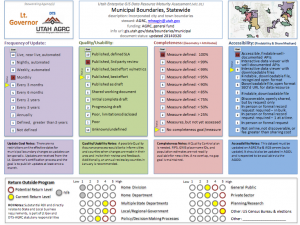By Bert Granberg on Mar 26, 2014
Give it a Try: One Page GIS Data Maturity Assessment
This article will take 2 minutes to read
Locational analysis, using GIS, is extremely powerful for discovering opportunity and other business analytics. GIS provides a platform to bring information together and facilitate organizations working together toward shared objectives. The foundation for success with GIS is unquestionably geographic data. Geographic data digitally models real world phenomena from across the natural, infrastructure, or societal realms -- and of course any combination of these.
 The effectiveness of GIS work hinges on the quality, completeness, currency, and accessibility of geographic data. Due to the demand for GIS technology, practitioners are pulled in many directions (analysis, app design/development, and of course map products) and often do not have time to set goals for data development and maintenance. Similarly, where goals have been defined, measuring, planning, and securing resources to meet the goals are often overlooked or the process and resulting product are often overly complex or bureaucratic.
The effectiveness of GIS work hinges on the quality, completeness, currency, and accessibility of geographic data. Due to the demand for GIS technology, practitioners are pulled in many directions (analysis, app design/development, and of course map products) and often do not have time to set goals for data development and maintenance. Similarly, where goals have been defined, measuring, planning, and securing resources to meet the goals are often overlooked or the process and resulting product are often overly complex or bureaucratic.
With this in mind, a multi-departmental technical committee comprised of GIS staff, representing DEQ, DNR, UDOT, DAF & SITLA, among others, is experimenting with a 1 page, graphic maturity assessment for GIS data. The assessment compiles for each GIS data layer the current status, goals, and overall value to users outside the immediate program/agency that stewards the data. While the immediate purpose of the assessment is supporting the multi-agency data-driven decision support effort in regard to the competing challenges in the Uintah Basin area, it should be applicable to just about any data stewarding context.
The assessment template is accessible via a shared online 'google presentations' powerpoint-style document, linked above. To fill out the maturity assessment form, users start by using the 'Make a Copy' command to save the template to their google account. Then its a matter of adding text, moving a status indicator, and coloring in boxes. The template comes with instructions and an example form filled out for Utah's statewide Municipal boundaries dataset. Its quick, its graphical, and the end product is accessible via URL for inclusion in metadata, for sharing with others, and other general external reference purposes.
The value returned on the Utah's investments in technology, staff, and data resources made to date is accelerating. The days of heavy data development 'lifting' are for the most part past us in Utah and the focus is on using GIS data to solve problems faster, better, and collaboratively. The demands on data stewards continues to grow and data maturity needs to be easily communicated to ensure realistic expectations and proper prioritization of resources.
If you're a data steward, consider giving the maturity assessment a try. It's a good thought exercise and could be an effective starting point for communicating additional needs, to-date successes, and the value of what you do. And, it might be a stepping stone to a more in-depth examination that is certainly warranted for more robust data layers. As usual, we would love suggestions on how to improve the template while keeping it simple. If you have feedback or would like to share your results, please send to the staff from AGRC at agrc@utah.gov or 801-538-3665.